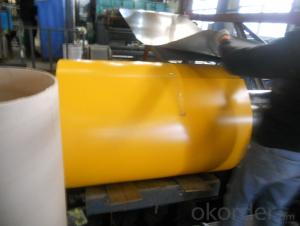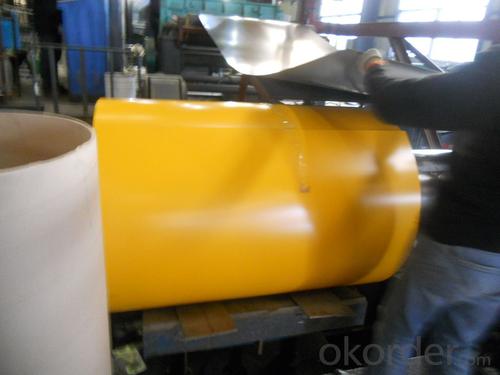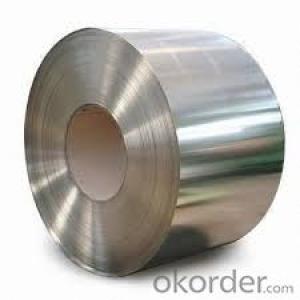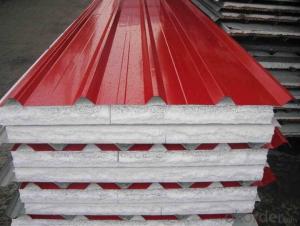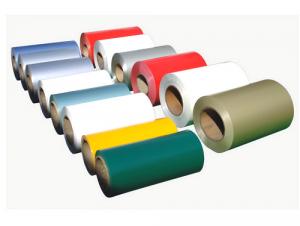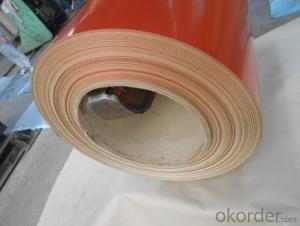PREPAINTED GALVANISED STEEL IN COIL
- Loading Port:
- China Main Port
- Payment Terms:
- TT OR LC
- Min Order Qty:
- -
- Supply Capability:
- -
OKorder Service Pledge
OKorder Financial Service
You Might Also Like
Product Description:
Prepainted galvanized color coated PPGI steel:
| Thickness | 0.12-1.2mm |
| Width: | 700-1250mm |
| Material: | SGCC,SGCD,SECC,SECD,DX51D+Z |
| Zinc coating: | 30-180G/M2 |
| Surface Structure: | galvanized ,zero spangle, regular spangle or normal spangle |
| COLOR: | RAL number or sample colour |
| Coating: | Topside: 5micron primer +15-20microns polyester Backside: 5-8microns primer epoxy. Surface treatment: chromated and oiled, chromated and non-oiled |
II Main characteristics :
1.strong corrosion resistance
2.surface quality
3.conducive to deep processing,such as corrugated steel sheet 4.economy and practicality
III Applications:
Household Appliance:
1.Refrigerator shutter &side panels, Washer, Freezers, Air conditions,
2.Rice Cooker, Microwave Ovens, Water Heaters, Sterilization Cabinets, Range Hoods
3.Computer Panels , DVD/DVB panels, TV back panel etc.
- Q: What are the different methods of annealing steel coils?
- There are several different methods of annealing steel coils, each with its own advantages and applications. The main methods include full annealing, process annealing, and spheroidize annealing. Full annealing is the most common method and involves heating the steel coils to a temperature above its critical point, typically between 800 and 900 degrees Celsius (1472 and 1652 degrees Fahrenheit), and then slowly cooling it down in a controlled manner. This process helps to refine the grain structure of the steel, making it softer and more ductile. Full annealing is often used to relieve internal stresses, improve machinability, and enhance the overall mechanical properties of the steel. Process annealing, also known as subcritical annealing or stress relief annealing, is a method used to reduce the hardness and brittleness of steel coils. It involves heating the coils to a temperature below its critical point, typically between 550 and 650 degrees Celsius (1022 and 1202 degrees Fahrenheit), and then slowly cooling them down. This process helps to relieve internal stresses that may have developed during previous manufacturing processes, such as cold working or welding. Process annealing is commonly used to improve the formability and toughness of steel coils. Spheroidize annealing is a specific type of annealing that is used to soften high carbon and alloy steels. It involves heating the steel coils to a temperature slightly below its critical point, typically between 650 and 700 degrees Celsius (1202 and 1292 degrees Fahrenheit), and then holding it at that temperature for a prolonged period of time. This allows the carbides within the steel to transform into rounded or spheroidal shapes, which increases the steel's machinability and ductility. Spheroidize annealing is often employed in the production of cutting tools, bearings, and other applications where improved machinability is desired. In addition to these main methods, there are also variations and specialized techniques that can be used for specific purposes, such as recrystallization annealing, intercritical annealing, and solution annealing. Each method has its own set of parameters and temperature ranges, and the choice of annealing method depends on factors such as the type of steel, desired mechanical properties, and the intended application of the steel coils.
- Q: What are the common coil thickness and width combinations available for steel coils?
- The specific requirements and standards of the industry can cause the available combinations for steel coil thickness and width to vary. Nonetheless, there are commonly used combinations that can be found. There is a range of options for coil thickness, varying from thin to thick coils. Thin coils typically have a thickness of 0.4mm to 3.0mm, while medium thickness coils can be around 3.0mm to 6.0mm. Thicker coils can range from 6.0mm to 25.0mm or even higher, depending on the specific application. The coil width also varies depending on the intended usage. Common options include widths of 600mm, 750mm, 900mm, 1000mm, 1200mm, 1250mm, and 1500mm. However, wider or narrower coils can also be available depending on the specific requirements of the customer or industry. Ultimately, the most suitable combination of coil thickness and width will depend on factors such as the intended application, manufacturing processes, transportation limitations, and customer preferences. It is crucial to consult with steel coil manufacturers or suppliers to determine the most appropriate options for your specific needs.
- Q: I worked REALLY HARD basically begged my dad to let me stretch my ear lobe piercings. He finally said yes, as long as I don't pass 2g. c: So, we went to Hot Topic to buy tapers, but I don't know if I should get Steel or Acrylic tapers. Which ones are better to start off with?
- Steel
- Q: In the warehouse management system of steel coil
- Warehouse is an important component of enterprise material supply system. It is also the tache of enterprise material circulation and storage, and it also undertakes many functions of material management. Its main tasks are to keep the stock well, to be accurate, to be of good quality, to ensure safety, to prompt the people, to produce, to be considerate, to reduce costs, and to speed up capital turnover.
- Q: How are steel coils used in the production of metal buildings?
- Steel coils are used in the production of metal buildings as they serve as the primary material for constructing the building's structural components, such as beams, columns, and trusses. These coils are unrolled and cut into specific lengths, which are then formed, welded, and assembled to create the framework of the metal building. The strength and durability of the steel coils ensure the longevity and stability of the structure, making them an essential component in the construction process.
- Q: How are steel coils used in the production of automotive chassis?
- Steel coils are used in the production of automotive chassis by being processed into flat sheets, which are then cut, shaped, and welded to form the structural framework of a vehicle. The high strength and durability of steel make it an ideal material for chassis construction, providing stability and protection to the vehicle's occupants.
- Q: I've heard different things bout them, though I do not know this. Oh, and if you know where you can buy some raw or get custom made stuff out of black steel please let me know it would be greatly appreciated. Oh and my friend told me there is a black steel that can be sharpened and silver will be underneath, is this also true? Thank you very much for answering ^^
- My son is a bit and spur maker,I asked him about that and he told me that it is a tag they put on bits so a novice person will pay more for a bit that is not any better. Steel is Steel You should have a lot of bite with that bit because it is a pretty fine diameter. The black patina will wear off with use. BTW he just sent two silver bits to a big show in Reno Nev. I have not seen them or pictures of them but he has a $2,000 price tag on each of them. They must be real elaborate probably very fancy spade bits with highly engraved multicolored different metal butterflies on the ports.
- Q: Is there any way to melt steel without the intense heat of a blast furnace?
- Iron melts at a very high temperature, so if the goal is to melt it, then there will be a certain amount of intense heat of course. Steel is recycled in a carbon arc furnace. The bottom is lined in graphite. Large graphite rods are lowered into iron scrap and enormous amounts of electricity melt the iron due to the heating of the carbon due to its resistance. The carbon also removes any oxides by forming CO2. Aluminum and lead can also be recycled in this fashion. Ordinary rust can be turned into liquid iron through the use of the thermite reaction. Rust and aluminum power can be ignited with a propane toarch or a magnesium ribbon fuse. The aluminum is oxidized and the rust reduced to molten iron. This reaction is used to spot weld cracks in steel structures, like railroad tracks. It is also a popular arson device used by spies.
- Q: What are the different methods of coil recoiling for narrow strip widths?
- There are several different methods of coil recoiling for narrow strip widths. One method is known as slitting and recoiling, which involves cutting the wide coil into narrower strips and then rewinding them onto a smaller coil. This is typically done using a slitting machine, which can make precise cuts to create the desired strip widths. Another method is known as edge trimming and recoiling. In this process, the edges of the wide coil are trimmed to create narrower strips, and then the remaining material is rewound onto a smaller coil. This method is often used when the edges of the coil are damaged or uneven and need to be removed before recoiling. Additionally, there is a method called tension recoiling. In this process, the wide coil is passed through a series of tensioning devices that help to create the desired strip widths. The tensioning devices can apply controlled pressure to the edges of the coil, allowing for precise recoiling of narrow strips. Furthermore, some companies use laser cutting technology for coil recoiling. This method involves using a laser beam to cut the wide coil into narrow strips, followed by rewinding onto a smaller coil. Laser cutting offers high precision and accuracy, making it an ideal option for narrow strip widths. Overall, the different methods of coil recoiling for narrow strip widths include slitting and recoiling, edge trimming and recoiling, tension recoiling, and laser cutting. Each method has its own advantages and is chosen based on the specific requirements and capabilities of the manufacturing process.
- Q: What are the guidelines for handling damaged steel coils?
- The guidelines for handling damaged steel coils typically involve assessing the extent of the damage, ensuring proper safety precautions are in place, and following industry best practices for handling and storing damaged coils. It is important to inspect the damaged coils for any potential hazards, such as sharp edges or protruding objects, and to use appropriate lifting equipment and protective gear when moving or transporting them. Additionally, damaged coils should be segregated from undamaged ones to prevent further deterioration and potential safety risks.
Send your message to us
PREPAINTED GALVANISED STEEL IN COIL
- Loading Port:
- China Main Port
- Payment Terms:
- TT OR LC
- Min Order Qty:
- -
- Supply Capability:
- -
OKorder Service Pledge
OKorder Financial Service
Similar products
Hot products
Hot Searches
Related keywords
